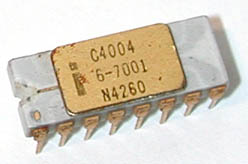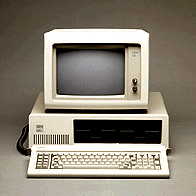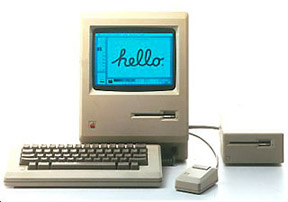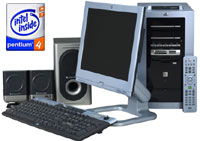|
Personal Computers Reduce Size and Cost
The introduction and availability of personal computers has not only enabled each of us to better record, locate, evaluate and communicate; it has given us new ways to provide better information, perform tasks better, and work more efficiently.
The MITS Altair 8800 was first introduced in the January, 1975 issue of Popular Electronics magazine as a construction project. By being offered as a complete kit it made it easy to obtain all the parts required for $397. A list of options including memory and a cassette interface kit were available to be added to the Altair at an additional cost. You needed BASIC, developed by Bill Gates and Paul Allen to run anything on the Altair, also an additional cost. The Altair is credited by many for beginning a new industry. The Apple II was released in 1977. It was factory built, in-expensive with a starting price of $1,195 (monitor extra), and easy to learn and use. The Apple II was provided with an extensive set of programs (including the Visicalc spreadsheet program introduced in 1979), low cost floppy disks, and was the first capable of color graphics and easy modem operation. Continuing developments added power and usability to the PC's, including IBM's Personal Computer XT, with either 64 or 128 kilobytes of memory, a dual-sided diskette drive and a high-performance fixed-disk drive in March 1983. A PC/XT configuration with a 10MB disk sold for $4995. Other companies such as Columbia Data Products and Compaq began to build computers that would run programs written for the IBM PC. Compaq shipped more than 53,000 portable PC's in 1983.
IBM introduced it's Personal Computer AT during 1984, the first Intel 80286 processor based PC, running at 6 MHz, with high density 1.2 MB 5.25 inch floppy disks, a 20 MB hard drive and 256 KB memory. The price was aproximately $6,000. IBM PC sales soon overtook Apple, reaching 40% of market share by 1985. IBM and Microsoft introduced a new operating system in 1987, OS/2, which provided access to multiple applications, large programs and data files, a graphical user interface and concurrent communication with other systems. The IBM PS/2 computer and Intel 80386 microprocessor were also introduced in 1987. New programs for word processing, spreadsheets, bookkeeping and other tasks took advantage of the new capabilities. IBM Style PC and Windows Dominate Personal Computer Market Microsoft introduced Windows NT 3.1 in 1993 to compete with IBM's OS/2. Microsoft Windows became the popular operating system of choice following the introduction of the less expensive Windows 95 in 1995. Today the IBM style PC running the Windows operating system continues to dominate the market. According to Gartner worldwide PC shipments totaled 59.1 million units in the third quarter of 2006, a 6.7 percent increase from the same period last year. 2006 sales show Dell ( 32.1 percent) and HP (23 percent) leading the US market, followed by Gateway (6.4 percent), Toshiba (5.1 percent). Gartner said Hewlett-Packard led worldwide PC shipments (16.3 percent), followed by Dell (16.1 percent), Lenovo (7.5 percent), Acer (5.9 percent) and Toshiba (4.3 percent). Apple's Macintosh (running the Mac OS X operationg system) sales account for an extimated 6.1 percent of the total United States market, as of third quarter 2006 a 31 percent growth compared to third quarter 2005. Personal Computers are used for a Wide Variety of Applications
Even in households, computers and the internet are widespread. In 2000 the US Department of Commerce reported that over half the households in the United States have a computer and an Internet connection. Consumers, like businesses, have learned to use the internet to search for, research and compare products and services by visiting manufacture and distributor web sites. Web sites often include catalogs distant customers can use to select and purchase goods.
|

 In
1971 Intel introduced the world's first single chip microprocessor, the Intel 4004. Running at
400 kilohertz it has as much power as the ENIAC. Intel's 8080 microprocessor, running at 2 MHz
was introduced in 1974. These and other inventions such as the floppy disk led to the introduction
of smaller desk top size computers.
In
1971 Intel introduced the world's first single chip microprocessor, the Intel 4004. Running at
400 kilohertz it has as much power as the ENIAC. Intel's 8080 microprocessor, running at 2 MHz
was introduced in 1974. These and other inventions such as the floppy disk led to the introduction
of smaller desk top size computers. The
IBM "Personal Computer" or "PC" was introduced in August 1981. It brought
together all of the most desirable features of a computer into one small machine at a starting
price of $1,565. It ran on a 4.77 MHz Intel 8088 microprocessor, came equipped with 16 kilobytes
of memory, one or two 160k floppy disk drives and an optional color monitor. The Microsoft Disk
Operating System "MS-DOS" was introduced with the new PC. Time magazine chose the "personal
computer" as its 1982 Man of the Year.
The
IBM "Personal Computer" or "PC" was introduced in August 1981. It brought
together all of the most desirable features of a computer into one small machine at a starting
price of $1,565. It ran on a 4.77 MHz Intel 8088 microprocessor, came equipped with 16 kilobytes
of memory, one or two 160k floppy disk drives and an optional color monitor. The Microsoft Disk
Operating System "MS-DOS" was introduced with the new PC. Time magazine chose the "personal
computer" as its 1982 Man of the Year.  Apple
introduced the Macintosh in January 1984. The Mac shipped with a graphical user interface and
mouse, 128 KB memory, a 400 KB floppy drive and was powered by an 8 MHz 68000 processor. The
price was $2,495.
Apple
introduced the Macintosh in January 1984. The Mac shipped with a graphical user interface and
mouse, 128 KB memory, a 400 KB floppy drive and was powered by an 8 MHz 68000 processor. The
price was $2,495. Today, almost all businesses rely on personal computers to keep records
and process information. The Personal Computer has been used for a long
list of business and consumer applications beyond word processing, spreadsheets
and bookkeeping. For example:
Today, almost all businesses rely on personal computers to keep records
and process information. The Personal Computer has been used for a long
list of business and consumer applications beyond word processing, spreadsheets
and bookkeeping. For example:
